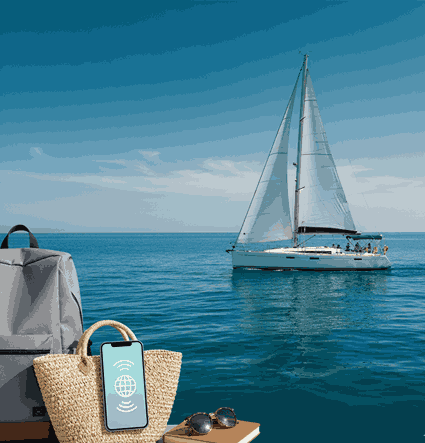Venice Carnival 2026 runs from February 7 to 17. If you’ve been dreaming about floating through canals in an elaborate 18th-century gown, this is your year.
- Official dates and schedule of Venice Carnival 2026
- The 2026 Venice Carnival theme: Olympus and Olympic spirit
- History of the Venice Carnival
- Planning Your Venice Carnival
- How many days do you actually need for the Venice Carnival
- Weather in Venice during February
- Venice Carnival Budget breakdown: costs and hidden expenses
- Where to Stay During Venice Carnival
- Best neighborhoods for Carnival access
- Hotels near San Marco Square
- Quieter stays in Cannaregio and Castello
- Lido as a budget-friendly base
- Getting Your Carnival Costume
- Venice costume rental shops and ateliers
- The Main Events of the Venice Carnival
- Flight of the Angel from San Marco
- Festa delle Marie parade
- Best Mask Contest in Piazza San Marco
- Opening ceremony on the Grand Canal
- Things to Do at Venice Carnival
- Il Ballo del Doge at Scuola Grande della Misericordia
- Tiepolo Ball at Palazzo Dandolo
- Evening performances at Ca’ Vendramin Calergi
- Best Photo Spots for Carnival
- Early morning shoots at San Marco
- Campo San Zaccaria for fewer crowds
- Ca’ d’Oro and Grand Canal backdrops
- Burano Island for colorful settings
- Where to Eat During Carnival
- Best bacari for cicchetti near Rialto
- What to pack for Venice Carnival beyond your costume
- Read more
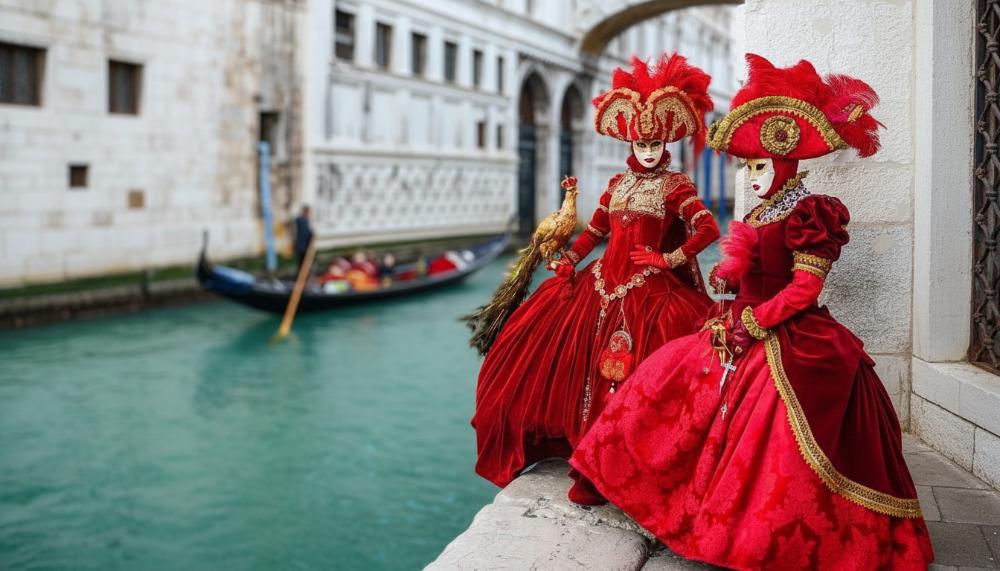
The city transforms into a living theater where masks become tickets to another era. I’ve put together everything you need: dates, costs, where to stay, which events matter, and the insider moves that set tourists apart from those who truly experience Carnival.
Official dates and schedule of Venice Carnival 2026
The 2026 edition brings fresh energy with its Olympic-themed celebration. Venice Carnival 2026 kicks off on February 7 and wraps up on February 17, the day before Ash Wednesday. That gives you 11 days to experience everything from grand balls to street theater.
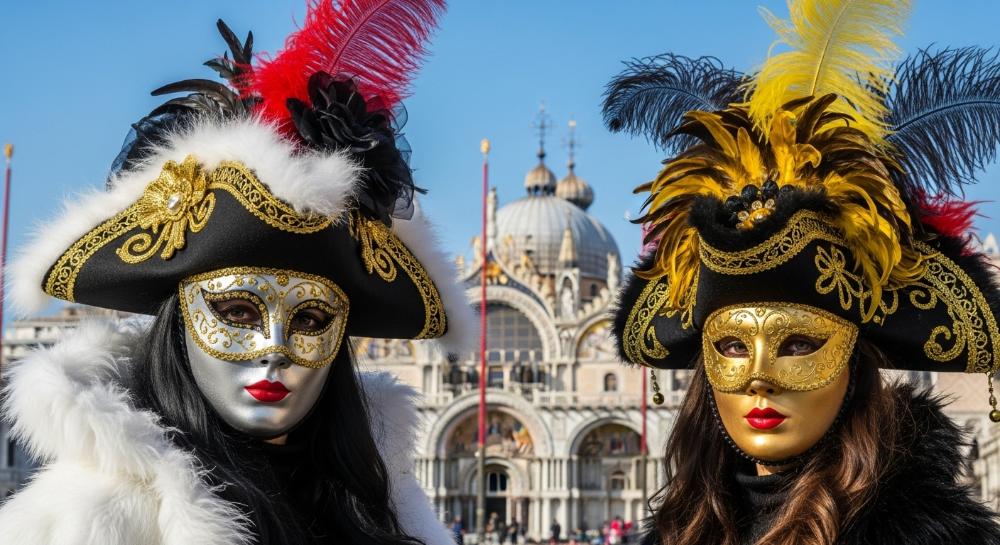
Most major events cluster around Piazza San Marco, but smaller neighborhoods host their own celebrations. Cannaregio throws parties that locals actually attend. Castello offers quiet corners where you can watch costumed figures drift past historic churches.
The 2026 Venice Carnival theme: Olympus and Olympic spirit
This year’s theme celebrates gods, glory, and athletic excellence. Think togas, meeting tricorn hats, Greek laurels woven into Venetian masks.
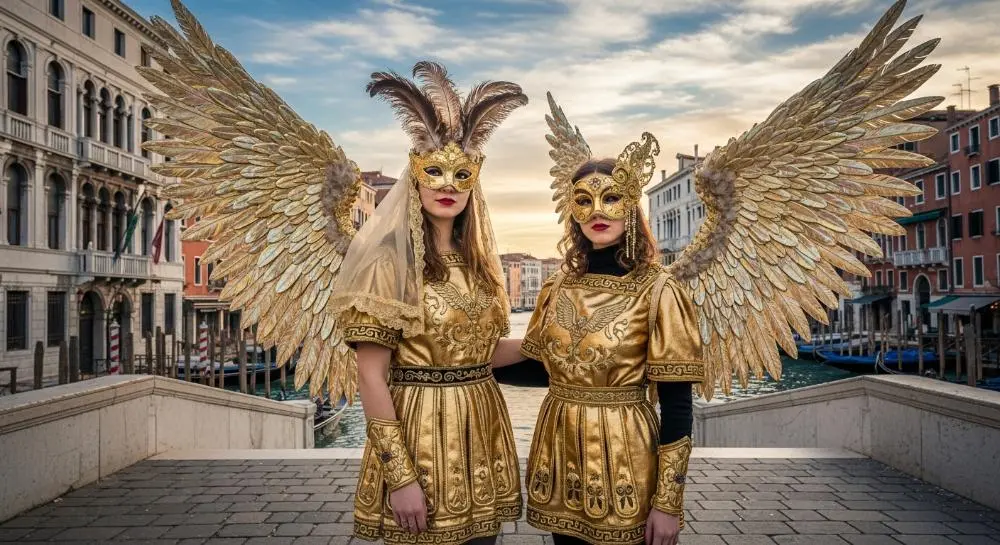
Expect costumes that blend classical antiquity with baroque Venice. Golden tunics, feathered wings meant to evoke Hermes, masks shaped like Zeus’s thunderbolts.
History of the Venice Carnival
Carnival in Venice dates back to at least the 11th century. It started as a celebration before Lent, a last burst of indulgence before forty days of fasting.
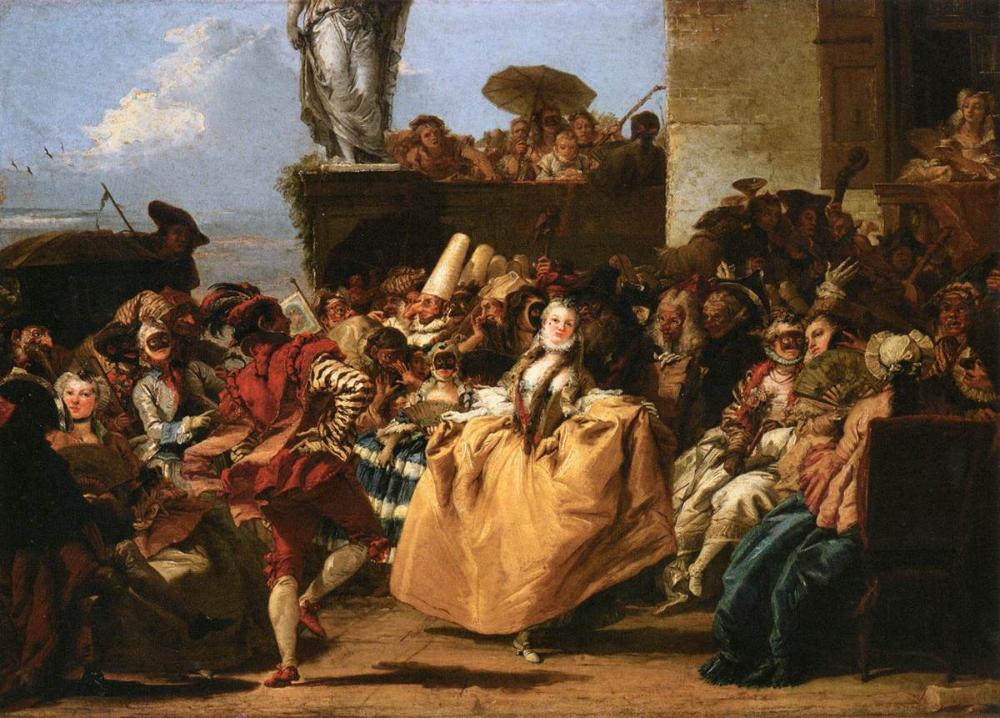
Masks gave Venetians something radical for their time: anonymity. Behind a bauta or moretta mask, a servant could joke with a nobleman. Social hierarchies blurred, if only for a few weeks.
Napoleon banned Carnival in 1797 when he conquered Venice. It stayed dormant for nearly two centuries until the city revived it in 1979 as a way to draw tourists and celebrate Venetian heritage.
“The mask is not to hide who you are, but to show who you can be.” — Traditional Venetian saying
Now it’s one of the world’s most famous festivals, drawing hundreds of thousands of visitors who come to dance, pose, and lose themselves in a city that perfected the art of spectacle.
Planning Your Venice Carnival
Hotels fill up fast, especially anything near San Marco or with Grand Canal views. Start looking in September or early October. By January, you’re choosing from what’s left, and rates will be double or triple the normal price.
How many days do you actually need for the Venice Carnival
- 3 full days give you a solid Carnival experience. You can attend 1 major ball, catch the Flight of the Angel, wander costumed through the streets, and still have time for museums or a quieter island escape.
- 5 days is ideal if you want to attend multiple balls, explore neighborhoods beyond the tourist core, and take a day trip to Burano or Murano.
- 10 days lets you live it all, but honestly, Carnival’s intensity can wear you down. Unless you’re deeply into photography or costume culture, a week is plenty.
Weather in Venice during February
February in Venice is cold and often damp. Average temperatures hover between 3°C and 10°C (37°F to 50°F).
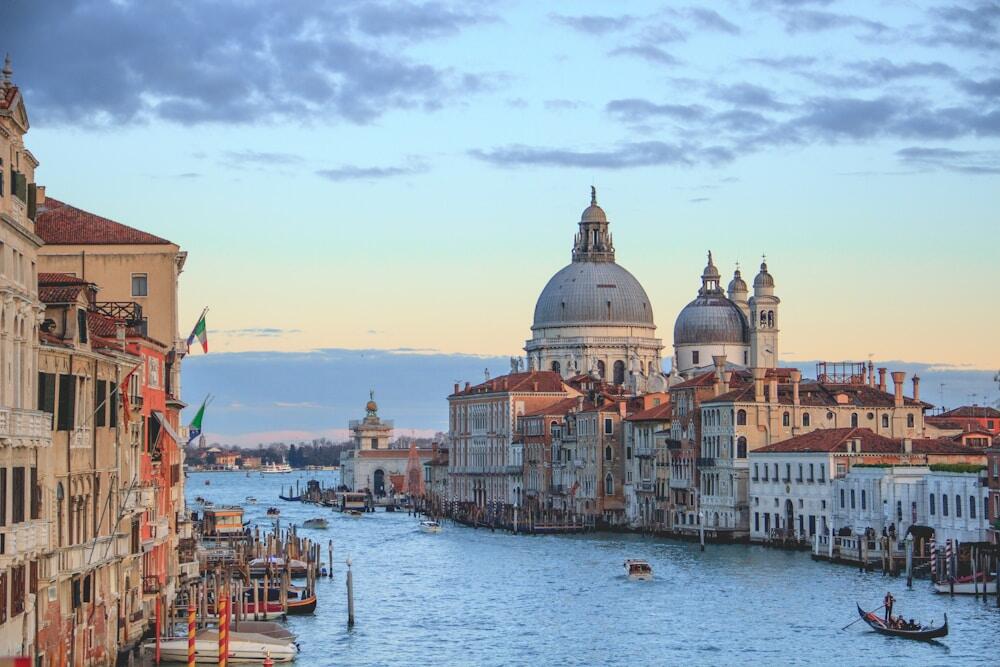
Rain happens. Fog rolls in thick over the canals, which actually makes everything look more atmospheric. Snow is rare but possible.
Here’s what to pack:
- Waterproof coat or jacket
- Layers you can add or remove
- Comfortable waterproof boots (you’ll be walking for hours)
- Gloves and a scarf
- Compact umbrella
Acqua alta, Venice’s famous high water, can flood parts of the city. Check forecasts and bring boots that can handle wet streets.
Venice Carnival Budget breakdown: costs and hidden expenses
Let’s talk real numbers. Carnival isn’t cheap, but you can control costs if you know where the money goes.
| Budget Option | Mid-Range | High-End | |
|---|---|---|---|
| Accommodation (per night) | €80–€150 | €150–€300 | €300–€800 |
| Costume rental | €150–€300 | €300–€600 | €600–€2,000+ |
| Masquerade ball ticket | N/A | €300–€500 | €500–€1,500 |
| Daily food | €30–€50 | €50–€100 | €100–€200 |
| Vaporetto pass (7 days) | €65 | €65 | €65 |
Hidden expenses add up. Coffee at a café in San Marco costs €6–€10 if you stand at the counter, more if you sit. Museum entry fees range from €12 to €25. Water taxis are convenient but expensive, starting at €60 for short trips.
Budget at least €1,500–€2,000 per person for a modest Carnival experience. That includes flights, three nights in a mid-range hotel, costume rental, meals, and one ball. Double it if you want luxury.
Where to Stay During Venice Carnival
Location determines your entire Carnival experience. Stay too far out and you’ll waste hours commuting. Stay in the chaos and you’ll never find peace. Choosing the right neighborhood shapes everything from your morning coffee routine to how late you can stay out at balls.
Best neighborhoods for Carnival access
San Marco puts you in the heart of everything. You’ll wake up steps from the main events, but you’ll also pay premium rates and deal with constant crowds.
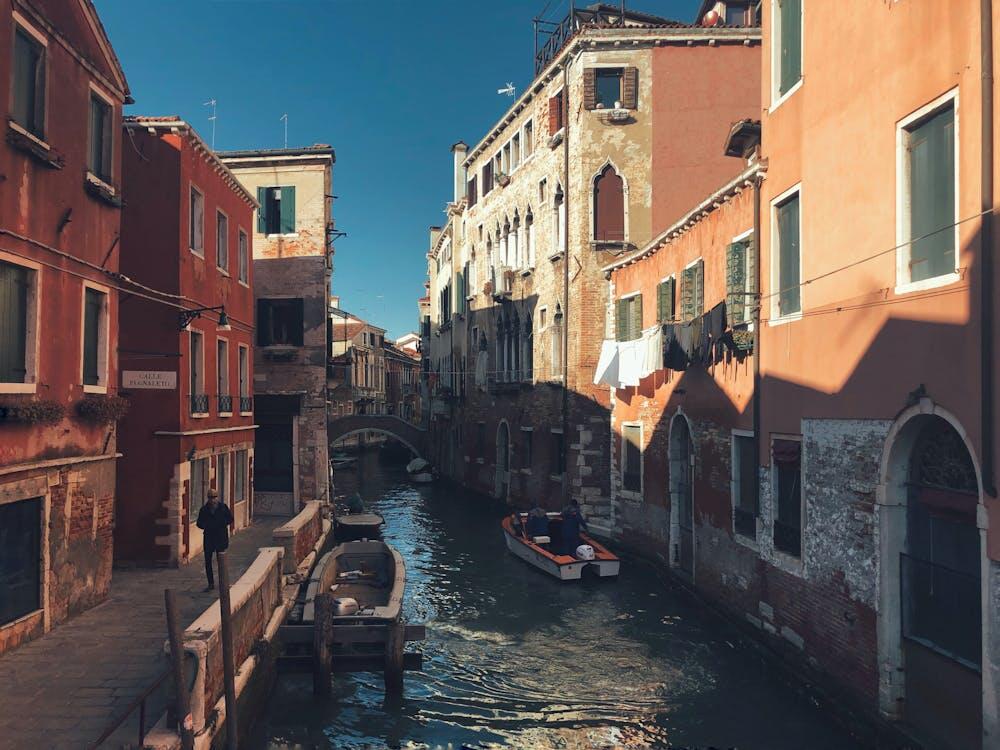
Cannaregio offers a better balance. It’s a 10-minute walk to San Marco, but it feels like actual Venice. You’ll find neighborhood bakeries, local bars, and canals without tour groups clogging every bridge.
| Neighborhood | Walk to San Marco | Vibe | Price Range (per night) |
|---|---|---|---|
| San Marco | 0-5 minutes | Tourist center, constant activity | €300-€800 |
| Cannaregio | 10-15 minutes | Local feel, good restaurants | €150-€350 |
| Castello | 5-20 minutes | Residential, peaceful | €150-€300 |
| Dorsoduro | 15-20 minutes | Artistic, bohemian | €180-€400 |
| Lido | 10 min by vaporetto | Beach town atmosphere | €80-€150 |
Castello is quieter still. It stretches east from San Marco toward the Arsenale, giving you space to breathe while keeping you close to the action.
Dorsoduro attracts art lovers and anyone who wants a more bohemian vibe. It’s home to the Peggy Guggenheim Collection and the Accademia, plus excellent restaurants that locals frequent.
Hotels near San Marco Square
If you want to roll out of bed and into the Carnival chaos, staying near San Marco makes sense for photographers who need dawn access and anyone attending multiple events daily.
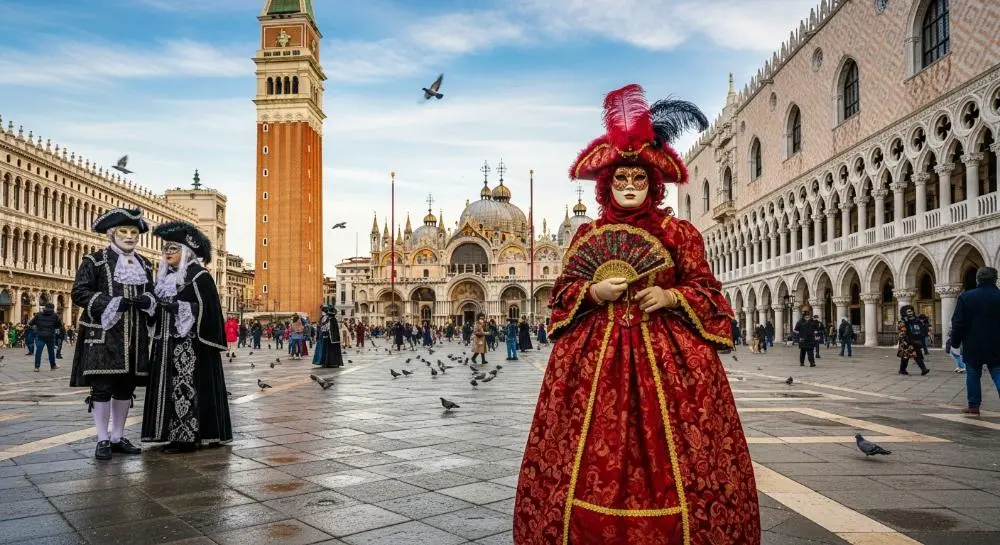
Top hotels in this area include:
- Hotel Danieli sits right on the waterfront with views of San Giorgio Maggiore, offering iconic luxury
- Palazzo Vitturi provides boutique elegance just off San Marco with smaller rooms that feel authentic
- Corte di Gabriela features a quieter courtyard setting, 2 minutes from the square
Expect to pay €300 – €800 per night during Carnival. Book directly with hotels when possible; you’ll sometimes get better rates or perks.
Quieter stays in Cannaregio and Castello
These neighborhoods give you Venice without the tourist theater while keeping you close enough to reach major events in minutes.
Cannaregio options:
- Al Ponte Antico overlooks the Rialto Bridge and offers elegant rooms in a historic palazzo
- Ca’ Sagredo Hotel blends frescoed ceilings with Grand Canal views
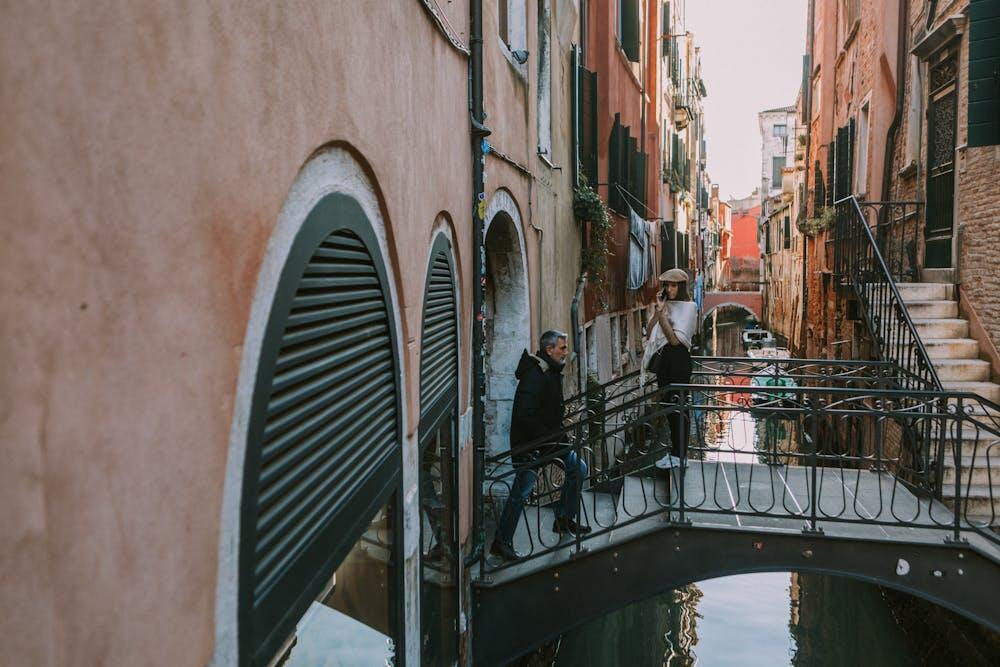
Castello is where Venetians actually live:
- Locanda La Corte provides boutique charm near Campo Santa Maria Formosa
- Hotel Bucintoro sits along the waterfront near the Arsenale with views toward San Giorgio
Prices here drop to €150–€300 per night, and you’ll eat better because restaurants cater to locals, not cruise ship crowds.
Lido as a budget-friendly base
Lido is Venice’s barrier island, a ten-minute vaporetto ride from San Marco. It feels like a beach town, with streets wide enough for cars and bikes.
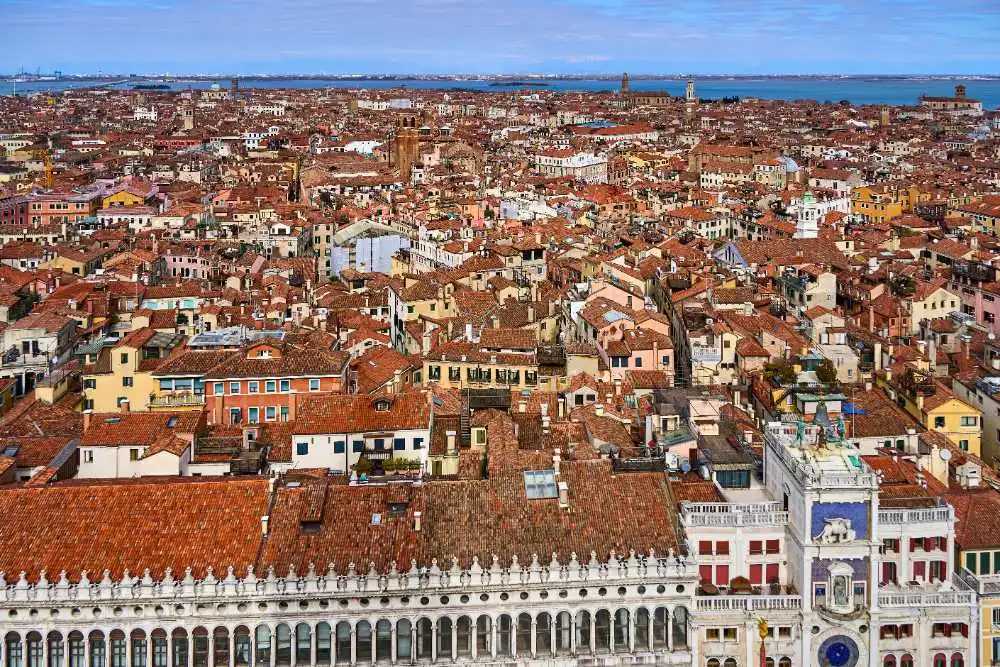
Hotels here cost significantly less. You’ll find clean, comfortable rooms for €80–€150 per night during Carnival.
Recommended Lido hotels:
- Hotel Ausonia & Hungaria offers old-world charm with garden areas
- Hotel Villa Pannonia provides elegant rooms without the San Marco markup
The trade-off is commute time. Factor in vaporetto schedules, especially late at night after balls end. The last boats run around 11:30 PM, with night service after that running less frequently.
| Lido Pros | Lido Cons |
|---|---|
| Significantly lower prices | Requires vaporetto for all trips |
| Quieter atmosphere for rest | Limited late-night transport |
| Local restaurants and cafes | Less immersed in Carnival atmosphere |
| Easier to find availability | 20-30 minutes to reach events |
Getting Your Carnival Costume
Your costume matters more than you think. It’s not just about photos; it’s your ticket into certain events and the key to feeling part of Carnival rather than just watching it.
Venice costume rental shops and ateliers
Venice has dozens of costume shops, but quality varies wildly. Some rent polyester monstrosities, others create museum-worthy pieces. Here’s how the main options compare:
| Shop | Price Range | Specialization | What’s Included | Best For | Booking Timeline |
|---|---|---|---|---|---|
| Atelier Nicolao | €600–€2,000+ | Film-quality costumes with hand-stitched details | Full costume, mask, custom fitting, authentic accessories (fans, gloves, jewelry) | High-end balls, serious photographers, historical accuracy | 4-6 months ahead |
| Ca’ Macana | €300–€600 | Mid-range quality, excellent masks | Costume, mask, basic accessories, fitting | Most events, good value for quality | 3-4 months ahead |
| Il Ballo del Doge | €400–€800 | Costumes designed for their ball | Costume, mask, accessories meeting ball standards | Specifically for Ballo del Doge attendees | 2-3 months ahead |
| Budget shops (various) | €150–€300 | Simple 18th-century outfits | High-end balls, serious photographers, and historical accuracy | First-timers, street photography only | 1-2 months ahead |
Most rental packages include the main costume pieces (dress, coat, breeches, or other period garments), a mask appropriate to your costume style, basic accessories needed to complete the look, and at least one fitting appointment for adjustments.
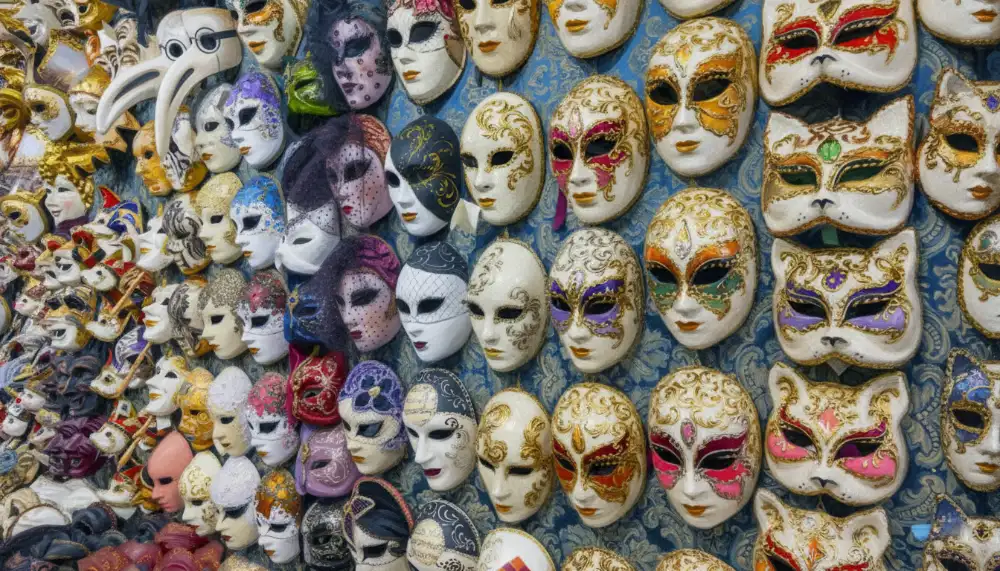
Watch out for additional costs that aren’t always included. Wigs typically add €30–€100 to your total. Period-appropriate shoes run €20–€80 extra. Specialty items like elaborate headpieces or weapons can add €50–€200. Rush fees for last-minute bookings often carry a 20–50% surcharge on top of the base rental price.
The Main Events of the Venice Carnival
Carnival throws dozens of events at you, but only a handful truly matter. Here’s what deserves your time and what you can skip.
Flight of the Angel from San Marco
This is Carnival’s most spectacular single moment. A performer, usually a celebrity or contest winner, glides down a cable from the Campanile bell tower to the stage in Piazza San Marco.
It happens on the first Sunday of Carnival, which falls on February 8, 2026. The flight takes place around noon, but get there by 10 AM if you want any chance of seeing it clearly.
Expect massive crowds. I’m talking shoulder-to-shoulder packed. Your best view comes from the arcades along the square’s edges, where you can see over people’s heads.
Festa delle Marie parade
This parade recreates a medieval Venetian tradition celebrating twelve young women chosen for their beauty and virtue. Participants dress in elaborate period costumes and parade from San Pietro di Castello to San Marco.
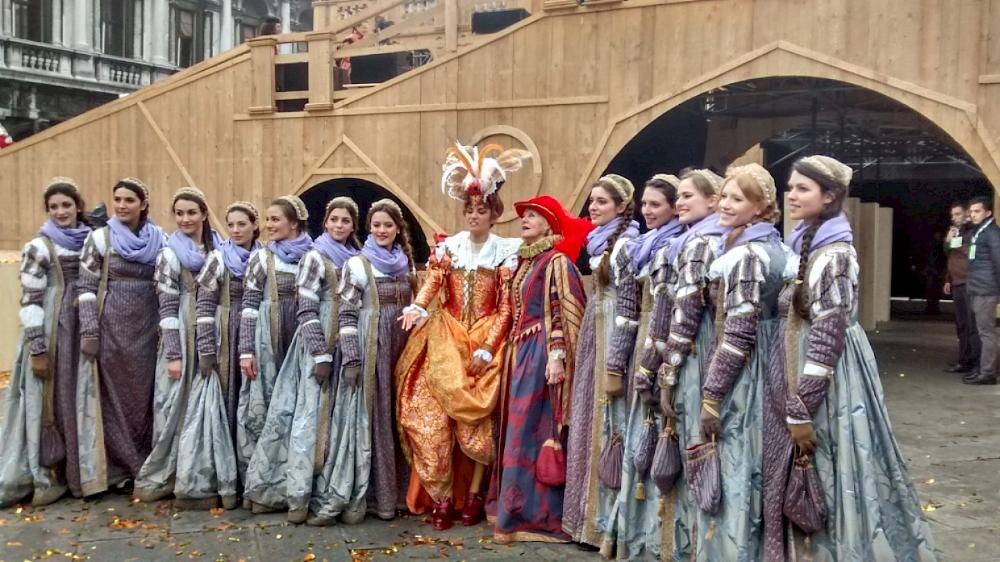
It typically happens on the first weekend, around February 7–8. The route winds through Castello’s quieter streets before entering the chaos of San Marco.
Watch it in Castello rather than at the finish line. You’ll see details you’d miss in the crowds, and you can follow the parade at your own pace.
Best Mask Contest in Piazza San Marco
Every day during Carnival, the Best Mask Contest draws competitors in elaborate costumes. They parade across the stage in San Marco while judges evaluate creativity, craftsmanship, and presentation.
“The best masks aren’t just beautiful. They tell a story, they transform the wearer, they capture something essential about Venice itself.” — Carnival judge’s commentary
The main contest happens on the final weekend, February 14–16. Winners receive prizes and recognition, but honestly, the real reward is the applause from thousands of spectators.
If you’re wearing a costume, you can register to compete. Even if you don’t win, it’s a thrill to step on that stage.
Opening ceremony on the Grand Canal
Carnival officially opens with a water parade on the Grand Canal. Decorated boats, musicians, performers, and fireworks kick off the festivities.
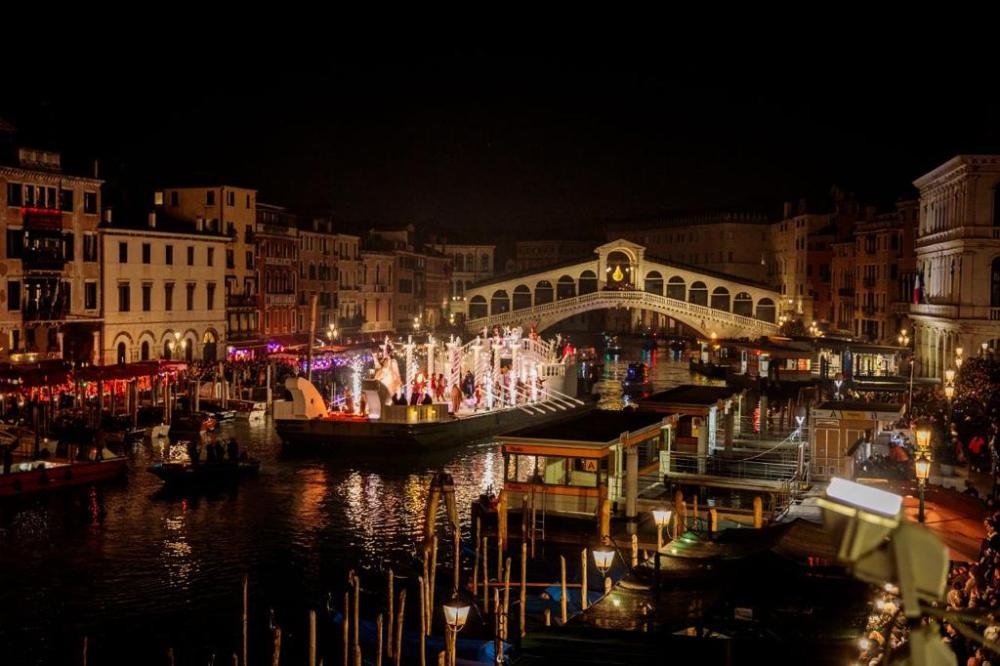
This happens on February 7, 2026, typically in the evening. The best viewing spots line the Grand Canal between the train station and Rialto Bridge.
Get there early. Venetians and tourists alike pack the canal-side walkways. Restaurants with canal views charge premium prices for window tables during the parade.
Things to Do at Venice Carnival
Beyond the official schedule, Carnival offers experiences that range from extravagant balls to spontaneous street encounters. Here’s how to fill your days and nights.
Il Ballo del Doge at Scuola Grande della Misericordia
Il Ballo del Doge is Carnival’s most famous ball. It takes place in the stunning Scuola Grande della Misericordia, a 16th-century building with frescoed ceilings and massive halls.
The 2026 dates will likely include February 8, 14, and 15. Check their official website for exact timing and ticket releases.
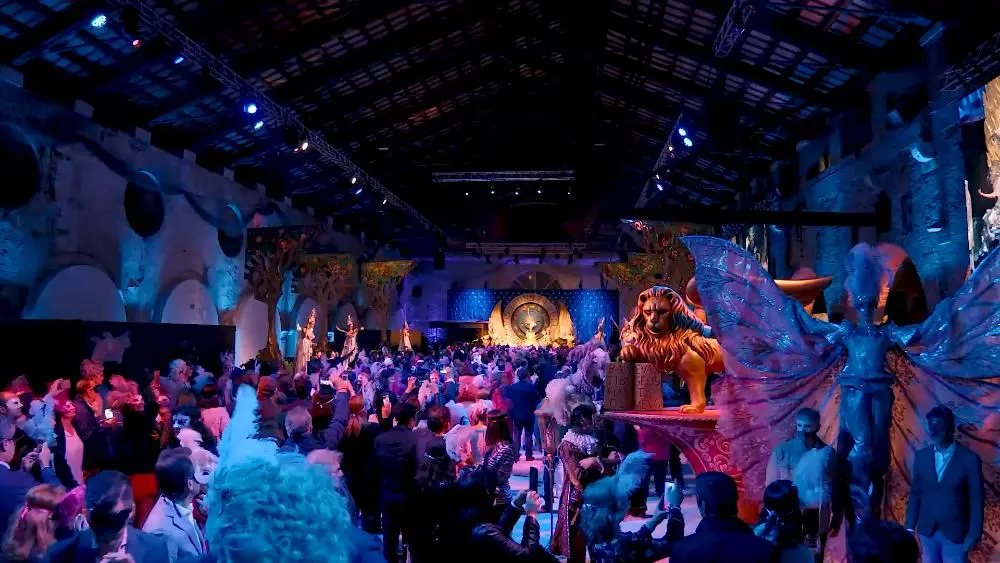
What sets this ball apart is the production value. Professional dancers perform choreographed numbers. The orchestra plays baroque music. Every room offers something different: a gaming salon, a dining hall, a ballroom for minuets and waltzes.
Tickets start around €800 for standard entry. VIP packages with reserved seating and premium food go higher.
Tiepolo Ball at Palazzo Dandolo
The Tiepolo Ball offers a more intimate experience in Palazzo Dandolo, a Grand Canal palace dripping with history. It’s smaller than Il Ballo del Doge, which means you’re not navigating seas of people.
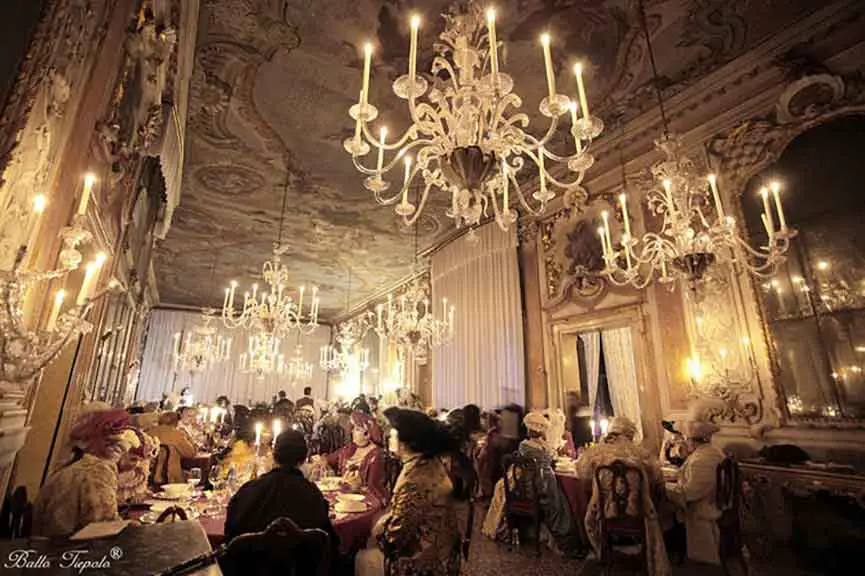
The organizers focus on authenticity. They teach period dances before the ball starts, so even beginners can participate. The orchestra plays baroque compositions, and the dress code is strictly 18th-century.
Expect tickets around €400–€600. The ball typically happens once or twice during Carnival, usually on weeknights when it’s easier to secure a spot.
Evening performances at Ca’ Vendramin Calergi
Ca’ Vendramin Calergi, where composer Richard Wagner died, hosts evening concerts and small performances during Carnival. These aren’t full balls but rather elegant gatherings with music, light refreshments, and costumed guests.
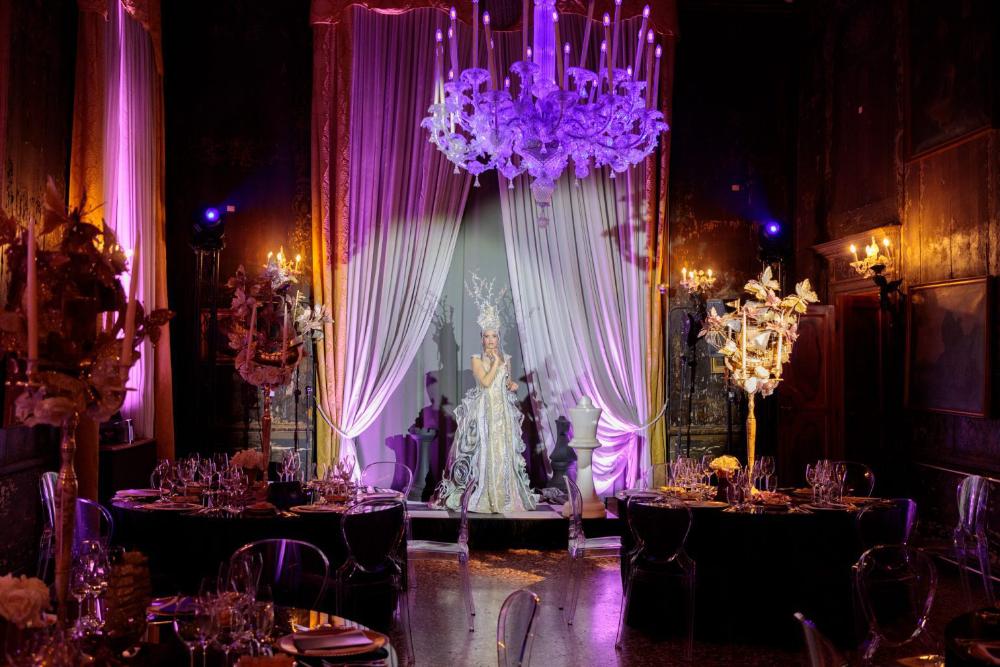
Tickets run €100–€200, making them more accessible than the grand balls. You’ll still get the experience of a historic palazzo, period music, and a chance to wear your costume without committing to a six-hour event.
Best Photo Spots for Carnival
Getting photos that capture Carnival’s magic requires knowing where to go and when. The difference between a good shot and a great one often comes down to timing.
Early morning shoots at San Marco
If you want iconic shots without crowds, set your alarm for 5:30 AM. Piazza San Marco at dawn is nearly empty, with mist rising off the stones and golden light hitting the basilica.

Bring your costume and a friend to help carry it. You’ll have maybe 90 minutes before tour groups arrive and the square becomes unusable for photography.
The arcades and columns provide perfect framing. Position subjects near the Doge’s Palace with the lagoon behind them for classic Venetian backdrops.
Campo San Zaccaria for fewer crowds
Campo San Zaccaria sits just behind San Marco but feels worlds away. The Gothic church provides architectural drama without the overwhelming crowds.
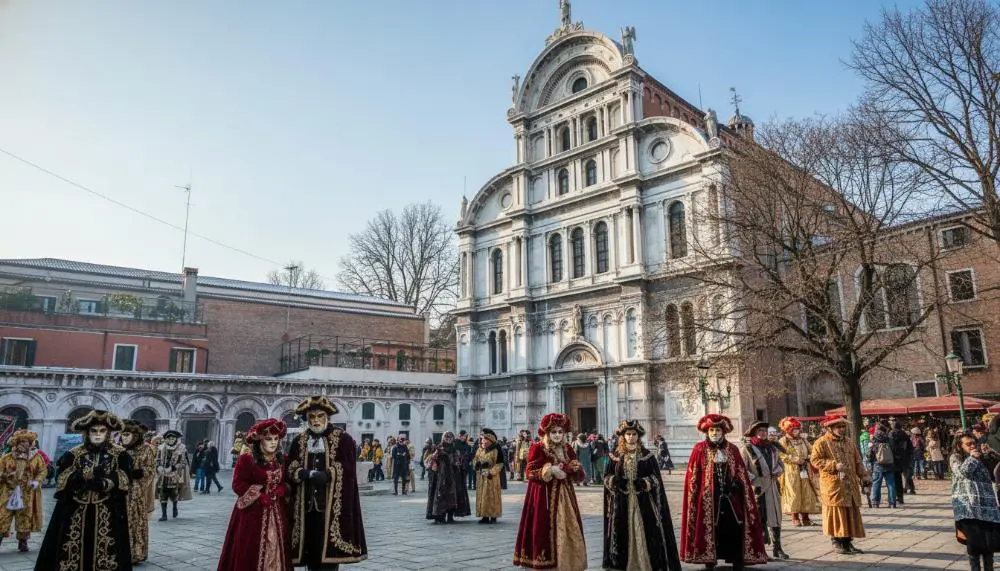
This spot works all day, but late afternoon offers the best light. The campo’s size lets you spread out, and you’ll often find other costumed participants posing here.
The bridge at the campo’s edge gives you canal views with the church in the background. It’s a favorite among local photographers who know the tourist hotspots have become too packed for quality work.
Ca’ d’Oro and Grand Canal backdrops
Ca’ d’Oro, the “Golden House,” is one of Venice’s most beautiful Gothic palaces. The building itself creates stunning backdrops, and the Grand Canal location adds water, gondolas, and constant movement.
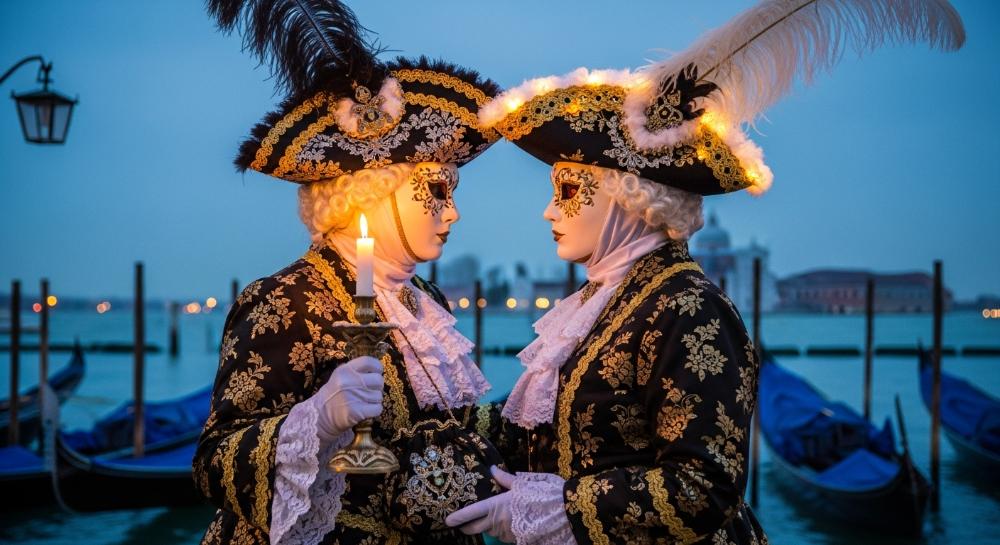
Get there mid-morning when light hits the facade but before crowds peak. The small campo in front gives you space to work.
The bridge near Ca’ d’Oro provides elevated angles looking down the Grand Canal toward Rialto. You’ll capture the essence of Venice: water, palazzos, boats, and masked figures drifting through it all.
Burano Island for colorful settings
Burano’s candy-colored houses make every photo pop. The island sits 40 minutes by vaporetto from Venice, which means fewer Carnival crowds.
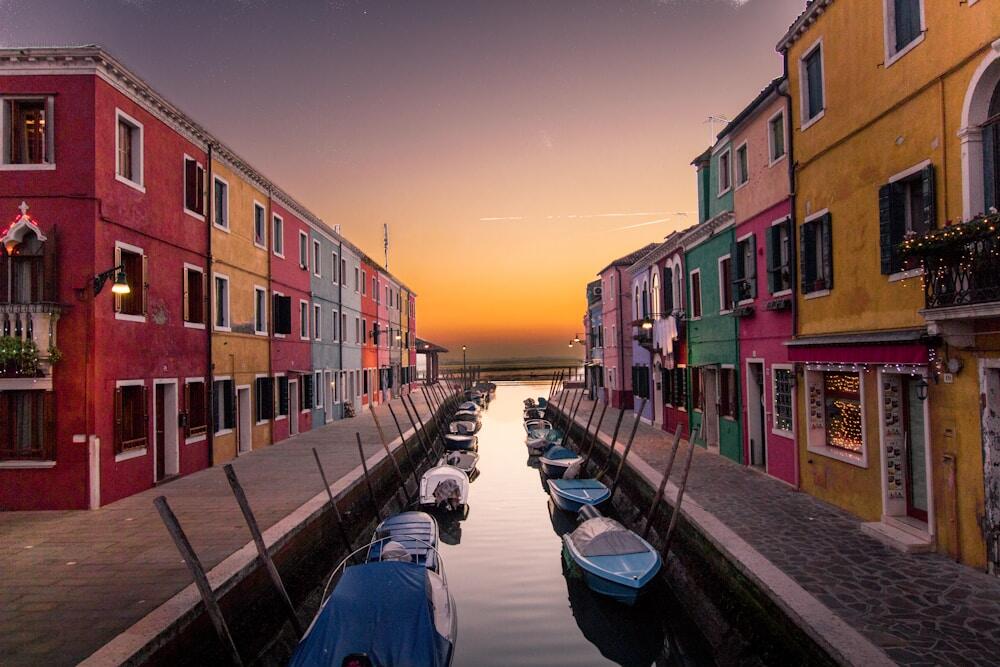
The contrast works beautifully: elaborate 18th-century costumes against bright yellow, orange, and purple house facades. The canals here are quieter, the bridges less crowded.
Go in the afternoon when the light is soft. Burano also has its own small Carnival celebration on March 1, which gives you a second chance at photos if Venice proper overwhelmed you.
Where to Eat During Carnival
Food in Venice during Carnival requires strategy. Tourist traps multiply, prices spike, and finding authentic meals takes effort. Here’s how to eat well without getting gouged.
Best bacari for cicchetti near Rialto
Bacari are Venice’s version of tapas bars, serving small plates called cicchetti with wine. They’re where locals eat, especially during Carnival when sit-down restaurants get mobbed.

- Cantina Do Mori near Rialto claims to be Venice’s oldest bacaro. Stand at the bar with locals, order cicchetti topped with baccalà (salt cod) or crostini with various spreads, and wash it down with an ombra of house wine.
- All’Arco serves incredible sandwiches and small plates. Get there early; they close when they run out of food, which happens fast during Carnival.
- Osteria Al Portego in Castello offers more space and a huge selection of cicchetti. Prices stay reasonable: €1.50–€3 per piece.
What to pack for Venice Carnival beyond your costume
Here’s what makes your Carnival experience better:
- Portable phone charger (you’ll use your phone constantly)
- Small backpack or bag that works with your costume
- Blister bandages (you’re walking 10+ miles per day)
- Tide pen or stain remover (costume mishaps happen)
- Sewing kit for emergency repairs
- Plastic bags to protect your costume from rain
- Snacks for when you can’t find food
If you’re attending balls, bring different shoes for walking to and from the venue. Your period-appropriate shoes aren’t meant for cobblestone streets.
Venice Carnival rewards timing, planning, and knowing which moments matter. Book early, invest in a good costume, and pick one or two balls that fit your vibe.
The rest will unfold as you wander through centuries-old streets where every corner offers something unexpected. Go with curiosity, not a rigid itinerary.

